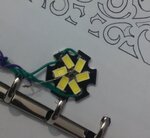J
Javid.zare.s
Guest

hi, since my powerbank didn't come with leds im planning to add 6 leds on it but the problem is that using them with resistors generates a lot of heat and I feel uncomfortable about this, so im thinking about using ne555 to perform high frequency& efficient driving. I couldn't find any circuit design that works for 6 leds ,so I'll be happy if you help me out.
power source 5v2a, I have 555 timeric and bunch of common transistors and resistors tnx
power source 5v2a, I have 555 timeric and bunch of common transistors and resistors tnx








